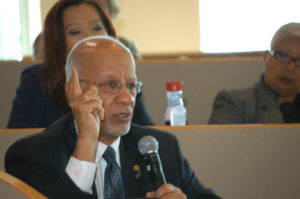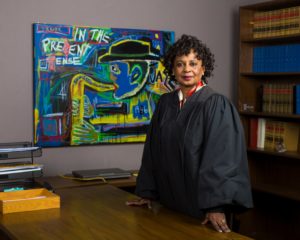By Robyn Johnson
(c) Connecticut Explored Inc., Winter 2022-23
Subscribe/Buy the Issue!
I am on a mission to preserve the stories of attorneys of color. I believe history is important to four journey—past, present, and future. My mantra, derived from an anonymous African proverb, is “Until the lion learns to write, the story will glorify the hunter.”
I became fascinated by the history of attorneys of color at the Women in Black induction ceremony in 2018. I was invited by the Connecticut Bar Foundation (CBF), a nonprofit organization dedicated to equal access to justice, to be included in its first historical preservation program. The CBF hosted more than 100 people at the Connecticut Legislative Office Building to unveil the historical photographs of 40 female judges. The photographs are part of the Connecticut Bar Foundation’s Women in Law history project displayed at Quinnipiac Law School. My photo is one of the 99 photographs on display.
The project seeks to record the path followed by female lawyers in their careers with a focus on work/life balance in the profession. As I walked among the other inductees and reflected on the relationships I had with women judges, I was astonished to learn I knew every female judge of color in Connecticut history, beginning with Judge Curtissa Cofield, who was appointed in 1990. My career as a prosecutor provided me the opportunity to appear before the Honorable Carmen Espinosa, the first Hispanic judge, who was sworn in to superior court on January 10, 1992. In 2013 Justice Espinosa became the first Hispanic justice appointed to the Connecticut Supreme Court. I was appointed to the bench in March 2013 as the 11th African American female in Connecticut Superior Courts. Since then I have mentored and inspired future judges and seen a significant increase in the number of appointments.
As a result of that experience, I took on the CBF’s second history project, “The History of Attorneys of Color,” which began in 2009. I became the chairperson of the committee in 2020. The group is composed of attorneys, students, and educators interested in preserving history. Our goal is to honor our similarities and differences, in our own words. I see my role as a connector to our ancestors in the legal practice and the future movement of social change.
The names of the first lawyers to hold important positions are recorded in Wikipedia for posterity, but there is a much deeper story to be told. For instance, the “affinity” bar associations in Connecticut reflect the rich diversity of the state’s bar: the George W. Crawford Black Bar Association (GWCBBA), founded in 1977, the Connecticut Hispanic Bar Association (CHBA), founded in 1993, the South Asian Bar Association of Connecticut ( SABAC), founded in 2004, and the Connecticut Asian Pacific American Bar Association (CAPABA), founded in 2000, each has had significant social, educational, and networking impact on the lives of its members. The bar associations’ members have made many contributions to the community in providing pro bono services, and their contributions deserve recognition. Minority law firms have provided legal services to Black Lives Matter protesters and conduct expungement seminars for ex-offenders seeking pardons. Many attorneys of color provide advice to relocating immigrant populations seeking proper work, visa, and identification documents.
On June 29, 2022, at Quinnipiac University School of Law, we held a symposium to celebrate the 10th anniversary of the project. A written timeline documenting the milestones of the attorneys was displayed for the attendees. The keynote speaker was our own trailblazer, Attorney Natalie Braswell, the first African American comptroller in the state of Connecticut, appointed by Governor Ned Lamont in December 2021. Attorney Braswell championed the impact the affinity bar associations had on her career and specifically honored Attorney John Rose. Attorney Rose is a founding member of the first affinity bar, GWCBBA. He and the original officers of GWCBBA envisioned a place for lawyers to meet, share information, and mentor young lawyers. Rose’s career, which spans decades, has led many lawyers to political office, partnerships, and judicial appointments. He was inspired by George Crawford, the first African American male lawyer to maintain a law practice in Connecticut, beginning in the early 1900s.
 Rose, who also has served as corporation counsel for Hartford and New Haven city governments, stated in his closing remarks at the symposium that he never foresaw the growth of the affinity bar movement to its current membership, with more than 500 lawyers registered across the four affinity bars. Rose’s story is one of many inspirational journeys that will be captured by this project, including those of new and emerging lawyers such as Denia Perez, who overcame her deferred action for childhood arrivals (DACA) immigrant status to be admitted to the Connecticut Bar in 2018.
Rose, who also has served as corporation counsel for Hartford and New Haven city governments, stated in his closing remarks at the symposium that he never foresaw the growth of the affinity bar movement to its current membership, with more than 500 lawyers registered across the four affinity bars. Rose’s story is one of many inspirational journeys that will be captured by this project, including those of new and emerging lawyers such as Denia Perez, who overcame her deferred action for childhood arrivals (DACA) immigrant status to be admitted to the Connecticut Bar in 2018.
My task is to preserve oral histories in one-hour video format. The recordings will be available through the CBF website and shared through the affinity bar associations. I hope to begin recording in 2023 with the first 16 honorees having been identified by the four affinity bar associations. The combination of oral history and the timeline will set the foundation for telling our story. I want future generations to see themselves in the stories of the pioneers. I see this as a legacy endeavor with the opportunity for expansion well into the future. My role in this mission is one step in the journey to preserve history.
Robyn Johnson is a judge of the Connecticut Superior Court assigned to hear criminal matters in the Hartford Judicial District.

